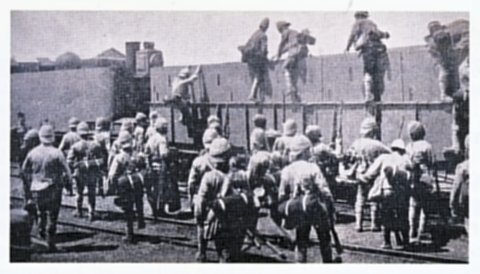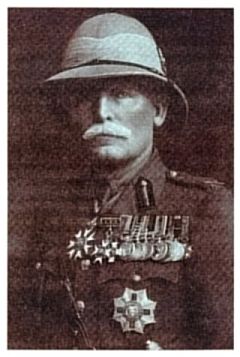

 The South African
The South African
Background
The ambush of a British armoured train near Frere, Natal, on 15 November 1899 is one of the best known incidents in the Anglo-Boer/South African War (1899-1902). On the train were 90 Dublin Fusiliers, 80 Durban Light Infantrymen, ten sailors with a naval gun, a telegrapher, a party of railway platelayers, and the young Winston Churchill, correspondent for the Morning Post.
The ambush was simplicity itself. Rocks strategically placed on the railway line derailed the three trucks in front of the engine, spilling their human cargo, primarily members of the Durban Light Infantry (DLI), onto the leeward side of the train, and bringing the train to a halt. With the engine acting as a battering ram, the DLI were able to clear the derailed trucks off the line. An enemy shell smashed the coupling between the tender and the trucks at the rear, thereby isolating the latter. Some of the wounded were placed on the locomotive and, with the platelayers hanging on wherever they could, the engine set off to run the gauntlet back to Estcourt about 15 miles (24km) away. According to A C Doyle and numerous other sources, Churchill had behaved with great courage during the engagement, encouraging the men clearing the line and persuading the driver to persist in using the engine as a battering ram.
With the engine on its way again, Churchill set out to find the detrained members of the DLI so that he could lead them back to their base at Estcourt. Nobody can accuse him of lacking self-confidence! He failed to find them and, instead, was himself taken prisoner by the Boers. Enemy fire prevented the Fusiliers in the rear trucks from escaping and when the engine steamed away, they had no option but to surrender. The Boer leader, Louis Botha, delighted by the success of the ambush, cabled Pretoria: 'The engine broke loose and returned badly damaged. Loss of enemy 4 dead, 14 wounded and 58 taken prisoner, also a mountain gun .... Our loss 4 slightly wounded'. Five days later, Churchill sent his famous dispatch to the Morning Post which brought him instant recognition and propelled him into Parliament at the next election.
It had been an absurd idea to send the train to scout along the railway line that day and almost everyone, except Col Long in command at Estcourt, was aware of this fact. As far as military planning was concerned, the incident was forgotten and accounts of the engagement end with the capture of Churchill.

The action of the Natal Volunteers
There is more to the story, however. Exclusive of civilians, over 180 men had set out on the train and Louis Botha's cable explains what had happened to 76 of them. If one allows for ten wounded men in the cabin with the driver and fireman, it would still leave almost 100 men unaccounted for and this is where the military significance of the incident lies.

When the sound of gunfire was heard in Estcourt, Major Duncan McKenzie was ordered to go to the relief of the armoured train with his squadron of 45 men of the Natal Carbineers (NC) and a squadron of 80 men of the Imperial Light Horse (lLH). The Carbineers were a local volunteer regiment consisting primarily of farmers who knew the country intimately and were wary of any new attempt by the Boers to expel the English settlers from the Colony of Natal, as they had tried unsuccessfully to do in 1842. Financed by taxes from the gold mines, the Boer commandos were equipped with the latest weaponry. Thus the Natal Volunteers' training had been adapted to deal specifically with the dangers posed by mounted men who were good marksmen armed with modern long-range rifles. The men of ILH, although an Imperial regiment paid by Britain, had been recruited in Natal and were quick to learn the methods employed by other Natal Volunteers.
After riding a few miles, the contingent of Volunteers met the engine with the wounded. Major McKenzie was told what had happened. It had begun to rain steadily, but the two squadrons pressed forward along the line of the railway as quickly as possible. Near the siding of Ennersdale, they passed a group of fleeing infantry trying to make their way back to Estcourt. As they hurried along, they also passed other groups before they finally sighted the Boers pursuing the hindmost infantry. The Boers checked their pursuit at the first sign of the presence of the Volunteers and retired in a north-easterly direction until they came to a wire fence. While they were cutting the fence, the Carbineers opened fire on them from concealed positions at a distance of about 800 yards (730 metres), killing several Boers, who were later found dead on the field (Stirling, p23). Once through the fence, the Boers took up a position on a kopje. In the exchange of fire which followed, the Boers appeared to suffer casualties. On observing that the fire from the Boers was becoming more intense, Major McKenzie ordered the Carbineers to retire; an orderly was also sent to the ILH with instructions to follow suit. The Volunteers retired along the railway line in extended order, with the Carbineers on the left and the ILH on the right. Being locals, familiar with the lie of the land, they were able to conceal their movements from the enemy, who, disconcerted by their inability to see the enemy or gauge their strength, gave up the chase after a few miles. Watching the Boers unsaddle in the open, McKenzie estimated that they numbered between three and five thousand (Natal Carbineers' Diary; Col A G McKenzie, Delayed Action).

Vulnerable on foot against mounted men, there is no doubt that all the infantrymen fleeing from the armoured train ambush would have been captured had McKenzie's men not intervened. His small force of 125 men had held at bay at least 3 000 men, thereby enabling more than half of the men from the train to get safely back to base. Throughout the action, McKenzie had taken great care to conceal the strength or disposition of his force. By placing their emphasis on marksmanship during training, the Natal Volunteers were able to strike hard when the enemy was vulnerable, before melting back into the veld. As a result of this tactic, the Carbineers suffered no casualties on the day and the only casualty of the ILH was one man wounded. Duncan McKenzie had given his first demonstration as to how invaders might be defeated.
The British Army appeared to take little or no notice of the methods used by McKenzie to protect the fleeing infantry. Regular British Army officers at the time generally had a very low opinion of the Volunteers and limited their relationship with them to giving and receiving orders. However, there was, on his way to Natal, a British officer who was prepared to break the mould and listen to the advice and opinions of local Volunteer officers, but that is another story ...
Source of images:
Photographs by courtesy of John McKenzie
Sources:
Doyle, A C, The Great Boer War, and numerous other authorities.
Stirling, J, The Colonials in South Africa, Naval and Military Press Reprint.
Natal Carbineers Diary
McKenzie, Col A G, Delayed Action
Return to Journal Index OR Society's Home page
South African Military History Society / scribe@samilitaryhistory.org